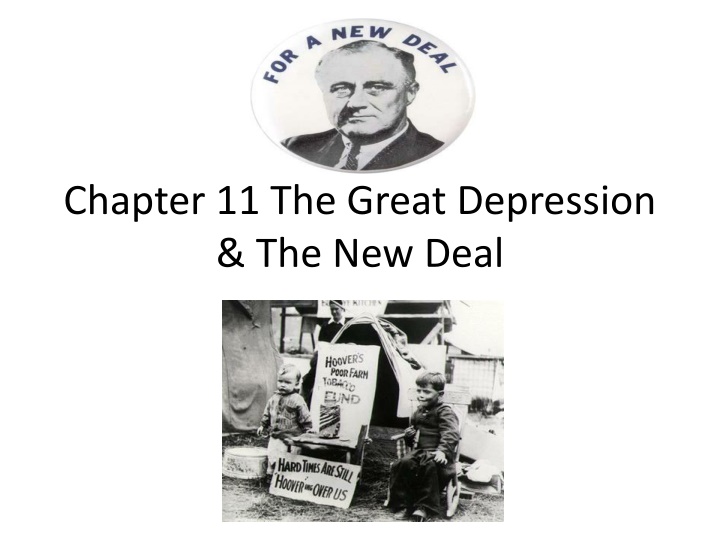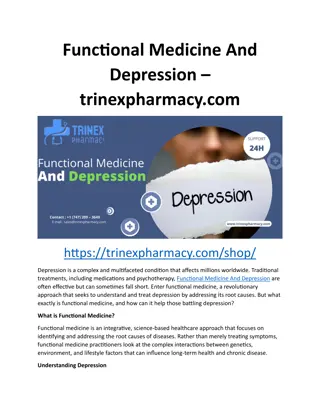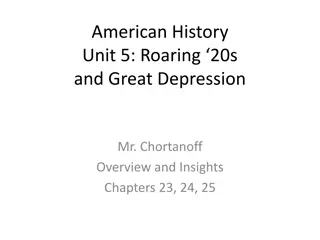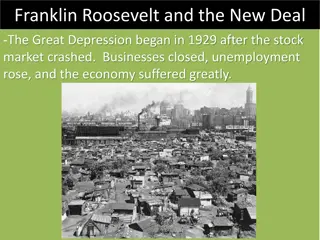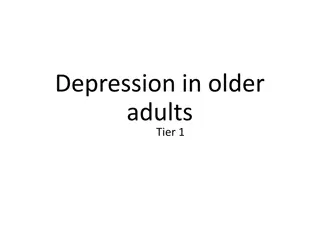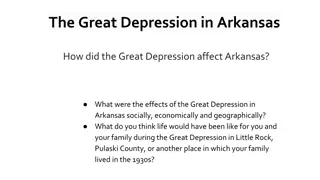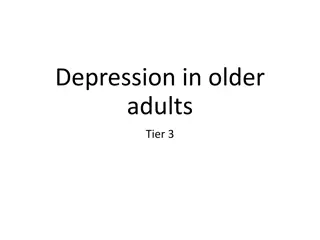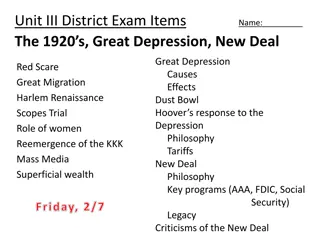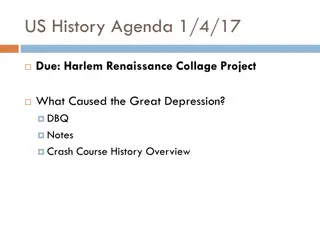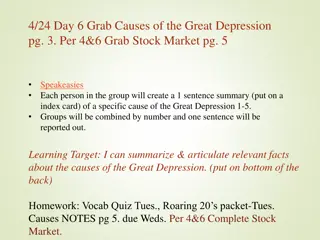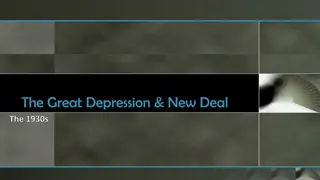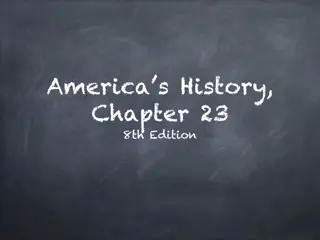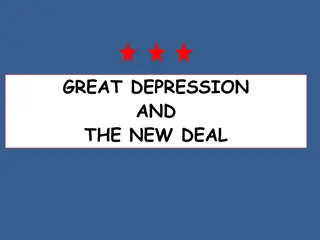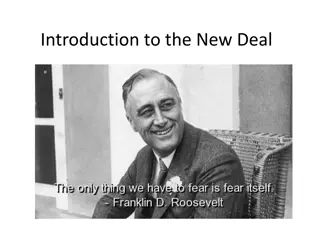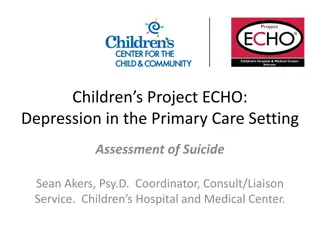The Great Depression and the New Deal: A Historical Overview
The content covers key events during the Great Depression and the implementation of the New Deal, including the Stock Market Crash, Hoover's presidency, the Veterans Protest, the Election of 1932, and the impact of the Depression in 1932-1933. It discusses economic challenges, political responses, and societal implications of this turbulent period in American history.
Download Presentation

Please find below an Image/Link to download the presentation.
The content on the website is provided AS IS for your information and personal use only. It may not be sold, licensed, or shared on other websites without obtaining consent from the author.If you encounter any issues during the download, it is possible that the publisher has removed the file from their server.
You are allowed to download the files provided on this website for personal or commercial use, subject to the condition that they are used lawfully. All files are the property of their respective owners.
The content on the website is provided AS IS for your information and personal use only. It may not be sold, licensed, or shared on other websites without obtaining consent from the author.
E N D
Presentation Transcript
http://411716811493059747.weebly.com/uploads/1/5/8/6/15862444/4339770_orig.jpghttp://411716811493059747.weebly.com/uploads/1/5/8/6/15862444/4339770_orig.jpg Chapter 11 The Great Depression & The New Deal http://resourcesforhistoryteachers.wikispaces.com/file/view/hard-times-hoovering-over-us.jpg/133605463/376x295/hard-times-hoovering-over-us.jpg
The End of the Roaring 1920s The Stock Market Crash was a sign of worst things to come Part of the reason for the Stock Market Crash was the buying of great amounts of stock on margin By 1927 there were signs the boom was ending
Hoovers Passive Efforts Hoover asked businessmen to maintain wages and layoffs in order to keep purchasing power strong By early 1933, 13 million were out of work Hooverville
Midterm Elections of 1930 In the 1930 elections the Democrats won a majority in the House of Representatives Hoover s critics called his measures trickle- down theory
Veterans Protest: The Bonus Expeditionary Force The marched on D.C. in an attempt to get immediate payment of a veterans bonus that Congress had approved in 1924 Hoover sent the U.S. Army to evict them from their Hooverville
The Election of 1932 Republicans nominated Hoover again, but were not that hopeful Democrats nominated Franklin D. Roosevelt FDR s campaign song was Happy Days Are Here Again FDR won by a landslide, 23 million to 16 million votes 472 to 59 in the Electoral College Hoover FDR
The Depression in 1932-1933 25% of Americans were unemployed 500,000 people had lost their homes or farms b/c they could not pay their mortgages Thousands of banks had failed therefore millions lost their life savings There was world-wide depression helping the rise of fascism & communism
20th and 21st Amendments The 20th Amendment changed the date of the president being sworn in to January 20th and the newly elected Congress to January 3rd The 21st Amendment ends the Prohibition of alcohol
The First 100 Days One of the first things the FDR did was to declare a bank holiday Emergency Banking Relief Act fireside chats Congress passed 15 major proposals with unprecedented speed
Help to Property Owners and Getting Confidence Back Emergency Farm Mortgage Act & Farm Credit Act Home Owners Loan Act The Banking Act & The Federal Deposit Insurance Corporation Securities ad Exchange Commission
Relief Measures Civilian Conservation Corps (CCC) Federal Emergency Relief Administration (FERA) Civil Works Administration (CWA) Works Progress Administration (WPA)
Recovery Through Regulation The Agricultural Adjustment Act & the (AAA) The National Industrial Recovery Act (NIRA) The NIRA created the Public Works Administration (PWA) NIRA created the National Recovery Administration (NRA) Tennessee Valley Authority (TVA)
Continuing Hardships By 1939, still 9.5 million workers (17%) of workers unemployed Petty theft on the rise, street begging, homelessness, & prostitution Low divorce rate but fathers deserted their families 900,000 children homeless tramps
The Dust Bowl In the Southern Plains of the Midwest and the Mississippi Valley there was a environmental catastrophe in the 1930s By 1938 over 25 million acres of prairie land had lost most of its topsoil 800,000people left and headed for the Far West where they believed there was work
Minorities And the New Deal The Great Depression was very traumatic on disadvantaged groups FDR failed to fight racism in the South b/c he didn t to lose the Southern Democrats Mexican Americans suffered as well
Popular Culture in the 1930s Outlets for Escapism Radio Programs: fireside chats, soap operas, verity shows, & dramas The talkies 70 million people saw at least one movie every week Popular movies were gangster films, animated cartoons, musicals, comedies and horror films
Criticism on the Right & the Left Kingfish Huey P. Long On the Right the Republicans and Conservative Democrats formed the American Liberty League To FDR s Left there was Huey Long, Francis E. Townsend and Father Coughlin hucksters of panaceas Francis E. Townsend Father Coughlin
Eleanor Roosevelt http://t2.gstatic.com/images?q=tbn:ANd9GcTYeVs76WY4Ews5OzJgYIMqiGjDUbHWhCSwKCTIxqeCwFWlDrGU FDR was more popular b/c of his wife B/C of FDR s affair with Lucy Mercer she had a independent life She wrote a syndicated column and held regular press confs. She fought for women s rights, black rights, & for youth.
The Second New Deal FDR decided to move to the left to stop the possible split of the party. The National Labor Relations Act The Social Security Act of 1935 The Revenue Act of 1935
The Election of 1936 Republicans nominate Governor of Kansas Alfred M. Landon Senator Long is assassinated FDR wins in a landslide Plus the Democrats dominate Congress: 328 to 107 in the House & 77 to 19 in the Senate Landon FDR
The Court-Packing Plan The Schechter Poultry Corporation v. U.S., the Supreme Court overturned the National Industrial Recovery Act The Court had ruled against New Deal programs 7 of 9 times In 1937, FDR proposed to reform the Supreme Court by adding 6 justices
A New Direction for unions B/C of the NIRA s demand that every industry code affirm the workers right to organize the Unions translated this that FDR wants you to join the union Unions grew in the 1930s In the General Motors Plant in Flint the sit-down strike was successful And Union workers became Democrats
Economic Slump & Elections of 1938 Concerned about federal deficits FDR ordered sharp cuts in spending in 1937 which caused an economic slump The conservative Democratic opposition to the New Deal was heaviest in the South FDR attempts to purge the Democratic party were unsuccessful in the elections of 1938
A Halfway Revolution FDR and the New Dealers went beyond the concept of regulation of capitalism by insisting that government not simply respond to social crises but also take positive steps to avoid them.
